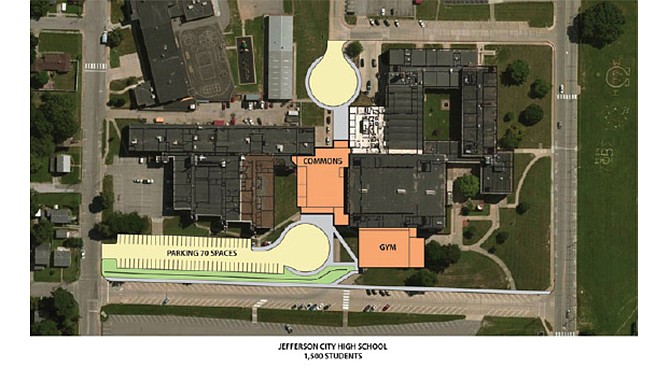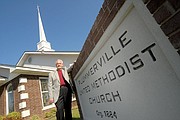What will it cost to build or renovate Jefferson City's high school facilities?
According to an architect's estimate - shared with the district's Long Range Facilities Planning Committee for the first time Thursday night - the costs range from $95.7 million to $155.9 million.
Last month, the committee asked Michael Kautz, an architect with ACI Boland, to develop preliminary cost estimates for three options. The three proposals - which call for educating 3,000 students - include:
• Option A: Renovating and expanding the existing high school campus.
• Option B: Renovating the existing high school and building a new high school.
• Option C: Building two new, separate high schools.
Kautz also came back to the committee with proposals for what it might cost the community to expand each option by 600 more students to address future growth.
All three would likely cost significantly more than the $79 million proposal voters rejected in April 2013. At the time, the $79 million would have been used to build a new high school along Missouri 179, to replace the aging facility at 609 Union St., and build a new elementary school on the city's eastern end.
While listeners in the room did not appear disheartened by the cost estimates, several held conflicting opinions of what voters may be willing to tolerate. Some of the two-high-school supporters think the community might back that idea. Others expressed skepticism that district patrons would support such a costly endeavor.
Rod Burnett, a committee member who favors two high schools, cautioned that Kautz's numbers are only estimates for a "wish list" of ideas the committee is interested in pursuing. He said the group could whittle the list down to something more sustainable in the weeks to come.
"This is a working document, a wish list," he said. "Now we have to come up with realistic solutions ... we can sell to the public."
It's likely the task force will now start to pick and choose from a menu of suggestions - seeking savings in some line-items, eliminating others - in order to trim the costs down to something school patrons might support.
The district has the capacity to borrow about $165 million under state law, but Jefferson City Area Chamber of Commerce CEO Randy Allen said it's moot. "Our tolerance for the size of the bond issue is way below what we have the capacity to fund," he said. "I literally would have to find another job after recommending a $155 million proposal, after a $79 million one failed."
Few of the committee members spoke favorably about keeping open Simonsen 9th Grade Center, the oldest structure in the system. Instead, they talked about the possibility of selling the building to Lincoln University.
Two years ago, both Linn State Technical College and Lincoln were interested in buying the 609 Union St. campus - and the refurbished Adkins Stadium - but that ship may have sailed.
Greg Gaffke, who serves on the Lincoln University Board of Curators, said both institutions are interested in the old St. Mary Health Center now. But, as envisioned by Kautz, the three options keep Adkins Stadium and the Miller Performing Arts Center as JCPS assets.
In his presentation Thursday, architect Michael Kautz painted a picture of what each cost option might include.
Option A: Renovating and expanding the existing high school campus
According to the Department of Elementary and Secondary Education, Jefferson City had about 2,618 students in grades 9-12 in September.
With a total cost of $95.7 million, this proposal makes room for almost 400 more - bringing the capacity to 3,000 - by renovating the 1964-era red brick building from stem to stern. The plans calls for spending $16.8 million to renovate the high school and another $10.8 million to renovate the old Nichols Career Center and add six classrooms. The plan also calls for spending $7.36 million to add a three-story, 30-classroom addition. The current media center/library would be converted to more classrooms.
A commons area would be built to connect the red-brick high school with the old Nichols Career Center. A new Nichols Career Center - at a cost of $10.2 million - also would be built.
Simonsen would be closed. Thorpe Gordon Elementary School would be demolished, and a new 400-student elementary would be built elsewhere.
The old wrestling and weight rooms would be demolished. But two gymnasiums, new locker rooms, a wrestling room and a weight room would be added for a cost of $10.3 million. The new sports facilities would be built to FEMA safety specifications, in the event of a disaster. However, building to FEMA standards almost doubles the costs, Kautz said.
The plan also calls for adding parking spaces. In the end, the 609 Union St. campus would have about 1,400 spaces - about 600 short of the 2,000 really needed, Kautz said.
Option B: Renovating the existing high school and building a new high school
This plan calls for creating two equal 1,500-student campuses by renovating the "old" high school and building a new one on the land the district owns east of Missouri 179 and north of the new St. Mary's hospital.
At the 609 Union St. campus, this plan calls for spending $16.8 million to renovate the high school and $5.9 million to renovate Nichols Career Center. More than $2.7 million would be spent to build an addition connecting the high school and Nichols Career Center in an effort to make the campus safer from intruders. The plan also calls for one new gym and a locker-room addition, which would allow the school to better comply with Title Nine federal laws that require equal sporting facilities for both boys and girls.
One of the concerns about both Options A and B is that renovation would likely have to occur while the building is occupied - a noisy and complicated proposition which could take three years to complete, said Kautz.
The two schools likely would share Adkins Stadium, but the new school would offer facilities with limited seating for football, soccer, track and field, baseball and softball games.
Kautz predicted that renovating the old high school ultimately would cost $40 million. Building the new high school would cost $76.4 million, for a combined cost of $116.4 million.
Many on the committee have deemed this option unlikely to move forward, since voters rejected a "mega school" in 2013.
Option C: Building two new high schools
This plan - the most expensive at $155.9 million - calls for building two new, balanced schools capable of handling 1,500 students each.
Since the school district already owns a 118-acre parcel of land it purchased for $3.1 million in the fall of 2012, that's where one of the new high schools would be situated. Building the school is estimated to cost $76.4 million.
The site for the second school is yet to be determined. Because the land hasn't been selected, the cost of the second school is estimated at $79.5 million.
Elementary schools
Building a new elementary on Jefferson City's eastern end could cost taxpayers about $13.8 million, the Long Range Facilities Planning Committee learned Thursday. The committee also considered renovating East Elementary School - at a cost of $2.04 million - and reducing the number of students who attend there.
One of the most-dilapidated schools in the district, according to an architects' study, East is also home to some of the most disadvantaged students - 87 percent qualify for free- or reduced-price lunches - who as a group perform the lowest on standardized tests.
The LRFP committee has been tasked with developing 20-year solutions to the district's space needs.
Although the group has also discussed hardening the district's buildings against intruders with more security apparatus, discussion of those projects is on hold until local law enforcement concludes an extensive study they've undertaken.
On Thursday, the group met with Kautz to hear his estimates for what it will cost to construct new elementary and middle schools and renovate older ones.
Although addressing the needs of East-End students is a top priority, Kautz offered cost estimates for five other projects the group wants to consider.
Those ideas include:
• Renovating Callaway Hills Elementary School and adding 10 classrooms at a cost of $5.5 million.
• Building a new elementary on the city's western border in 2022 at a cost of $19.3 million.
• Building a new Callaway Hills Middle School in 2019 at a cost of $34.5 million.
• Renovating Lewis and Clark Middle School in 2024 at a cost of $6.5 million.
• Renovating Thomas Jefferson Middle School in 2024 at a cost of $6.5 million.
Former JCPS Superintendent Chris Straub wanted to know if it would be possible to move 400 students into a brand-new school on the city's east end and still keep East Elementary, which is now 75 years old, open. He also was concerned about isolating the poorest students there.
Others on the committee said they believed that alleviating crowded conditions at other schools - like East and Thorpe Gordon - will make the new school more feasible. Altering elementary school boundaries, districtwide, was also discussed as a method for redistributing students.
A goal is to reduce class sizes at East Elementary, where some sections swelled to more than 25 students. If class sizes were reduced to 15 kids, parents would want to enroll their kids there, even if it wasn't the brand new building, suggested Brad Bates, a committee member.
"It doesn't help with the socioeconomic balance, but it does give them some support," Bates suggested.


